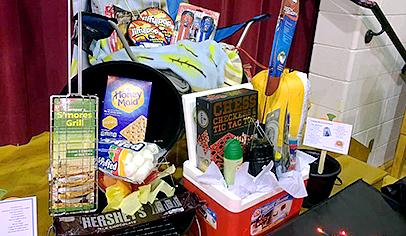Your group is exhausted after spending months preparing for that big event and a week making it happen. Now that it’s over, everyone can put their feet up and relax, right? Wrong! There’s one more very important step. Your team needs to let everyone know about its success.
Even if you’re worn out, even if you’re in the middle of yet another big to-do, you need to brag. All the stakeholders who contributed to this effort want to know the results of their support. Parents, students, teachers, staff, administrators, and the wider community want to be informed about how many children were touched by that musical program you put on or how much money was made in the gift wrap fundraiser or how you were finally able to install that wonderful new playground.
Taking the time to share the good news after every major event will make all of these individuals and businesses more inclined to continue their involvement as it cements your reputation as a parent group that gets things done. Reputation matters. Promoting a positive image can help draw in parents who might be staying away due to misperceptions about what the group does or how inclusive or welcoming it is. Public relations needs to be an ongoing effort to build and maintain your PTO’s public persona. This approach can help remake the reputation of a struggling group or further improve the reputation of a group that people admire.
So share your good news. Communication that simply celebrates may not seem vital, but it is. “One of the endless concerns of organizations is recruiting new people or keeping people engaged as volunteers,” says Susan Ellis, president of Energize Inc., a training, consulting, and publishing firm that specializes in volunteerism. “Part of the reason it’s difficult is that the only time people hear about you is when you’re asking them to help.”
All communication ought to begin with a specific strategy or goal in mind. For example, to encourage further volunteer involvement, you might post photos of volunteers laughing and cheering at the walkathon to show how much fun people have being involved. To recognize and motivate volunteers, you might send home a flyer that lists every parent who participated in the book fair. To demonstrate to school personnel the range of work the PTO does, put out an end-of-year summary of all PTO accomplishments. To show appreciation to business boosters, write personalized thank-you letters. To inform the public about a newsworthy accomplishment, send a press release to the local newspaper. And consider the kind of image you wish to craft for your group. Be careful that you’re not alienating some of your audience.
“If in your school there’s an attitude that the vast majority of active members are mothers, then start making sure that photos show fathers as well as mothers,” Ellis says. “Every time you put out a photo with only women or with people of one color or who are about the same age, then you are feeding a stereotype.”
Beyond the Newsletter Blurb
To reach as many people as possible, use multiple communication channels and varied formats. Perhaps the most common place to publicize results of a PTO event is the group’s website. Just make sure to produce information in a format that’s easy to read quickly, such as a monthly short bulleted report about major accomplishments. Another good idea is an annual summary. “At the end of each school year, we send out a PTO report card in a flyer,” says Amy Brown, PTO president at Harrisburg Journey Elementary in Sioux Falls, S.D. “It lists everything the PTO purchased with the money raised. Parents love to see that.”
And be sure to keep the website updated. “If a new family is thinking about getting involved, they will go the website,” Ellis says. “If they can’t get a feel for what the group has done recently, don’t be surprised if they think it’s a dead group.” Even with a great website, it’s a challenge to steer people to it. Be sure to include your URL on all communications. Fox Hill Elementary in Burlington, Mass., gives every family a refrigerator magnet with the website address as part of its welcome packet.
Emails are also a good way to share the results of the latest PTO activity. Keep the notes short, use the subject line to identify the content of the email, put any deadlines at the start of the email, and give the first and last name and title of all individuals mentioned. Make creating and sending emails (and managing all those addresses!) a breeze with PTO Today's Parent Express Email, a free parent group email tool.
Of course, not every family has Internet access or uses it regularly. Lake Pointe Elementary in Austin, Texas, has a simple system of stickers on folders to identify those parents who have requested paper information so that volunteers are able to quickly insert newsletters into certain students’ weekly envelopes, says PTO vice president Dinah Laughery.
Another way to make sure you reach everyone is to use intermediaries. At Carrillo Elementary in Carlsbad, Calif., PTO president Holly Ruderman emails information to each room parent. The room parent then forwards the emails to parents who are online and makes paper copies for others. “When you get a mass email, there’s a tendency not to pay too much attention, but you look more closely at an email that comes from a parent in your child’s classroom; it’s a little more personal,” Ruderman says. And since everyone gets her messages through some format, she says, “I feel like we’re not missing anyone.”
Also keep in mind barriers such as language. “You cannot reach the Hispanic community with a Caucasian hand,” says Lourdes Ferrer, a Hispanic academic achievement and parent involvement specialist and author of Hispanic Parental Involvement. She herself used to be that parent who didn’t feel a part of the school community, following a move from Puerto Rico. A mother of three, she had
never attended a PTO meeting. “Even though I came to the U.S. with a master’s degree, I didn’t speak the language, so I didn’t feel like I was at the same level,” she says. “I was embarrassed to park my car in front of the school and embarrassed by my accent. I thought, ‘Who am I to get involved in something so above me?’”
Ferrer recommends calling parents on the phone, translating newsletters into the languages that parents speak, recruiting parent leaders from minority communities, and using workshops to draw parents in. “Offer services parents want, like [information] about the GED or technology or raising their kids,” she says. “The more they’re in the school building, the more they’ll want to be connected.”
Reaching Out to the Community
To promote your accomplishments in the community, make use of local media for newsworthy happenings. The Fox Hill PTO has hoisted a banner in the town commons area, had messages programmed into a flashing computerized highway sign, hung flyers in the windows of local businesses, submitted information to the community news site patch.com, and promoted its school during a local cable station scholarship fundraiser.
“I don’t know how many parents watch the local channel, but the older community in town tends to click around and watch town debates and meetings,” says PTO copresident Gail Pinkham. “That clip ran through the month and gave us an opportunity to reach out to different audiences in the community.” Leaders at Carrillo also got the local morning news to film a segment on the school’s running club. Other schools send press releases to local newspapers and radio stations.
Photos and videos are also powerful. Ellis suggests setting up a webcam to stream events in real time “to let people know that if you can’t come, you can tune in.” She also suggests using a site like Picasa, which lets you make free photo albums. “Others can see the photos and download them and gain an investment in the activity,” she says. And don’t forget tried-and-true methods of reaching out, such as phone calls and bulletin boards.
PTO meetings are a place where many groups highlight results. Unfortunately, these meetings are not always well attended. So officers take their message to larger gatherings of parents. Parent group leaders at Boones Creek Elementary in Gray, Tenn., speak at grade-level meetings, says PTO president Amy Mahoney. Carrillo PTO leaders talk to new parents at the annual kindergarten orientation. The Fox Hill PTO piggybacks on evening talks given by the principal on such topics as the new report card. Other parent groups address the crowd at back-to-school night.
Principals can be great ambassadors for PTOs. The Fox Hill group gets some promotion from the principal through his blog. “He gives us a shout-out,” Pinkham says. At Harrisburg Journey in South Dakota, “Our principal talks about us all the time,” Brown says. “He tells new parents we’re incredible.”
Principals are also great for reaching students in celebratory gatherings with crazy antics. At Carrillo, the principal dressed in a chicken costume and performed a chicken dance during the assembly to celebrate a fundraiser’s success under a banner stating the amount of money raised. At Harrisburg Journey, the principal endures water balloons or pies tossed at him or being dunked in a tank when an event such as the readathon is successful.
Harrisburg Journey has a fundraiser that serves a promotional purpose, too. They have a bunch of plastic flamingos that people pay to have placed in someone’s yard. The flamingos are so well-known that they were used on a float in a local parade as a way to promote the school.
A thank-you is always a good opportunity to celebrate success. Businesses and individuals appreciate thank-you notes that specify the outcome of the event they helped support. The Fox Hill PTO keeps a running thank-you section on its website. The Isaac Dickson Elementary PTO in Asheville, N.C., thanked the parent who ran the fall bulb sale by presenting her with some potted flowers and a card at a meeting. “She’d never come to a PTO meeting before,” says PTO president Steve Agan. “Reaching out and giving a personal invitation to come to a meeting is important.”
Reporting on your successes pays off. “It’s important to share with all the people because so many generously give their time and financial support,” Ruderman says. “Sharing our successes makes them feel rewarded and excited and encourages them to get involved in other things. We doubled the size of our board as a result of sharing what we accomplished. We just have a good energy going.”
7 Ways To Share Good News
To publicize your parent group’s accomplishments, get the word out every way you can.
-
Photos: Include diverse volunteers to show that you’re an inclusive group. Post pictures on a site like Google’s Picasa so volunteers can download them and feel connected.
-
Meetings and workshops: Ask for time on the agenda at gatherings that draw parents, such as principal information sessions and parenting workshops.
-
Website: Keep your site updated with monthly bulleted lists of accomplishments. Include the URL on all communications to drive people to the site.
-
Emails: Use short emails to share results of PTO initiatives. Put the topic in the subject line.
-
Bulletin boards: Post news about your most recent success on school bulletin boards in areas where parents wait, such as in the main office.
-
Press releases: For newsworthy events, contact your local newspaper, news website, and radio and cable TV stations.
-
Room parents: Use room parents to contact smaller groups of parents. Recruit parents that represent the school’s cultural mix.

























